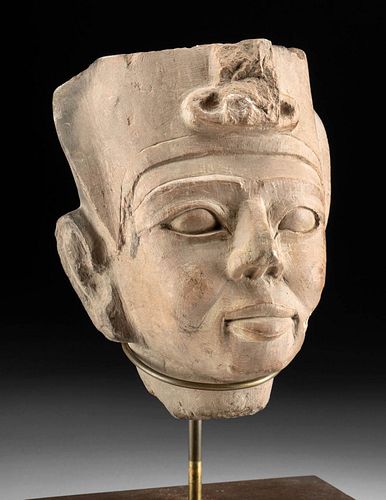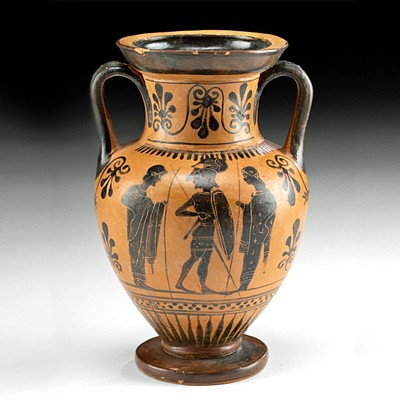Egyptian Stone Pharaoh Head, Sculptor's Model
About Seller
686 S Taylor Ave, Ste 106
Louisville, CO 80027
United States
Selling antiquities, ancient and ethnographic art online since 1993, Artemis Gallery specializes in Classical Antiquities (Egyptian, Greek, Roman, Near Eastern), Asian, Pre-Columbian, African / Tribal / Oceanographic art. Our extensive inventory includes pottery, stone, metal, wood, glass and textil...Read more
Two ways to bid:
- Leave a max absentee bid and the platform will bid on your behalf up to your maximum bid during the live auction.
- Bid live during the auction and your bids will be submitted real-time to the auctioneer.
Bid Increments
| Price | Bid Increment |
|---|---|
| $0 | $25 |
| $300 | $50 |
| $1,000 | $100 |
| $2,000 | $250 |
| $5,000 | $500 |
| $10,000 | $1,000 |
| $20,000 | $2,500 |
| $50,000 | $5,000 |
| $100,000 | $10,000 |
| $200,000 | $20,000 |
About Auction
Mar 9, 2023
Artemis Fine Arts info@artemisgallery.com
- Lot Description
**First Time At Auction**
Egypt, Late Dynastic to Ptolemaic Periods, ca. 664 to 30 BCE. A striking youthful male head of royal lineage, carved from a warm red hued stone, perhaps created as a sculptor's model or trial piece. The idealistic face is defined by slender almond-shaped eyes with thick lids and cosmetic trails extending from each corner. Upon his head is a khepresh headdress with the remains of an uraeus (coiled cobra) at the center. The khepresh, also known as the blue or war crown, was royal headgear that was ceremonial and perhaps symbolic of military achievement. Faces of kings in the round were popular during this period, and this particular piece may have been a model or "trial-piece" for the sculptor to practice or study before starting a final piece. Size: 5" L x 3.5" W x 6.5" H (12.7 cm x 8.9 cm x 16.5 cm); 11" H (27.9 cm) on included custom stand.
A carved head like this example may have served as a model for a larger sculpture, to teach apprentice sculptors how to replicate a master style, or to produce ushabti figures (small funerary statues for tombs). Though sculptors' models are typically difficult to date - with some being from the Amarna period of the 18th Dynasty when new forms of statuary came in - most known examples are from the Late Dynastic and Ptolemaic periods. The Egyptians were keen observers of fauna, with many different animals gracing their mythology, artwork, and hieroglyphs; however, anthropomorphic models were typically among the most challenging to carve accurately.
While sculptors' models appear to be from larger composite figures, their incomplete presentation could be an entirely separate item typology. Ancient Greek sculptural incompleteness was a generic form of presentation as the viewer could extrapolate who or what a sculpture was meant to represent. In contrast, the ancient Egyptians would view an incomplete votive work of art only as it was: part of a bird, a disembodied head, or in one instance the hind quarters of a lion. According to Eric Young of the Metropolitan Museum of Art, "When we consider the Egyptian pieces as sculptors' models, however, their incompleteness is no longer disturbing, but entirely understandable. As is the case with unquestioned sculptors' models...the apprentice sculptor concentrated his energies on those portions of the figure that he found intriguing, or most difficult, and the master sculptor demonstrated the correct way to delineate a head…" ("Sculptors' Models or Votives? In Defense of a Scholarly Tradition." The Metropolitan Museum of Art Bulletin, March 1964, p. 255).
PLEASE NOTE: Due to recent increases of shipments being seized by Australian & German customs (even for items with pre-UNESCO provenance), we will no longer ship most antiquities and ancient Chinese art to Australia & Germany. For categories of items that are acceptable to ship to Australia or Germany, please contact us directly or work with your local customs brokerage firm.
Provenance: private Hawaii, USA collection, acquired 2000 to 2010; ex-Tom Richard Cavanaugh collection, Boothbay Harbor, Maine, USA, acquired before 1980
All items legal to buy/sell under U.S. Statute covering cultural patrimony Code 2600, CHAPTER 14, and are guaranteed to be as described or your money back.
A Certificate of Authenticity will accompany all winning bids.
We ship worldwide and handle all shipping in-house for your convenience.
#177426Condition
Losses and chips throughout as shown, losses to right cheek, uraeus, and earlobes. Great preservation to facial details.
- Shipping Info
-
All shipping is handled in-house for your convenience. Your invoice from Artemis Gallery will include shipping calculation instructions. If in doubt, please inquire BEFORE bidding for estimated shipping costs for individual items.
-
- Buyer's Premium



 EUR
EUR CAD
CAD AUD
AUD GBP
GBP MXN
MXN HKD
HKD CNY
CNY MYR
MYR SEK
SEK SGD
SGD CHF
CHF THB
THB














